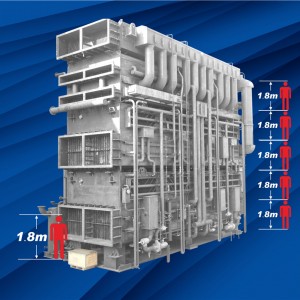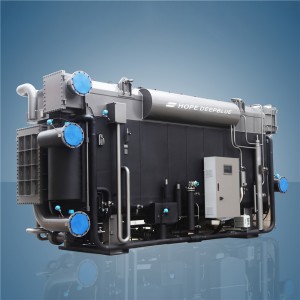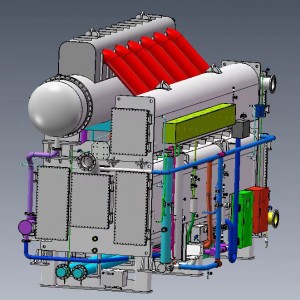
Products
Exhaust&Hot water absorption chiller
2.1 Working principle
At one atmosphere of pressure, water boils at 100°C, but at 0.00891 atmospheres, its boiling point drops to 5°C. Water's boiling temperature decreases as pressure decreases. If we can create an environment with very low pressure—or high vacuum—where water boils and evaporates, we can achieve a cooling effect.
The exhaust gas&hot water chiller operates on this principle, causing water to boil and evaporate on low-pressure evaporator heat transfer tubes to absorb heat and produce low-temperature chilled water. Clearly, to maintain continuous evaporation and heat absorption in the evaporator, refrigerant water must be constantly replenished while the evaporated refrigerant vapor is continuously removed. This function is achieved through the absorption properties of LiBr solution.
2.2 Flow diagram
Cooling process:
The working principle of the exhaust gas&hot water LiBr absorption unit is shown in Figure 2-1. The dilute solution exiting the absorber is pumped by the HTG pump through the low-temperature heat exchanger into the LTG. Within the LTG, the dilute solution is heated by hot water and high-temperature refrigerant vapor from the HTG, concentrating into intermediate solution while simultaneously producing refrigerant vapor. After heating the dilute solution in the LTG, the high-temperature refrigerant vapor condenses into refrigerant water. Through U-tube, together with the refrigerant vapor generated in the LTG, it enters the condenser where it is cooled by the cooling water to become refrigerant water.
The intermediate solution from the LTG splits into two streams. One stream is pumped by the LTG pump through a high-temperature heat exchanger into the HTG. Heated by high-temperature exhaust gas or fuel gas, it produces high-temperature refrigerant vapor, further concentrating the solution into a concentrated solution. After cooling through the high-temperature heat exchanger, this concentrated solution mixes with the other intermediate solution stream to form a mixed solution.
The refrigerant water produced in the condenser passes through a U-tube before entering the evaporator. Due to the low pressure in the evaporator, part of the refrigerant water evaporates. The majority of the refrigerant water is pumped by the refrigerant pump and sprayed onto the evaporator heat exchanger tubes. It absorbs heat from the cooling water flowing inside the tubes and evaporates, thereby lowering the temperature of the cooling water within the tubes and achieving the refrigeration effect.
A mixed solution is pumped by the absorber pump through the low-temperature heat exchanger into the absorber. It sprays onto the absorber heat exhanger tubes, where it is cooled by the circulating cooling water. After its temperature drops, it absorbs the refrigerant vapor from the evaporator, becoming a dilute solution. Thus, the mixed solution continuously absorbs the refrigerant vapor generated by the evaporation of refrigerant water in the evaporator, enabling the evaporation process in the evaporator to proceed continuously. The LiBr solution, now diluted by absorbing refrigerant vapor from the evaporator, is pumped by a solution pump to the HTG for boiling and concentration. This completes one refrigeration cycle. As this process cycles endlessly, the evaporator continuously outputs low-temperature chilled water for cooling air conditioning systems or industrial processes.
Heating process:
The cooling water circuit and refrigerant water circuit stop operation, with the chilled water circuit switching to a hot water circuit. The dilute solution in the absorber is pumped by the LTG pump and HTG pump to the LTG and HTG, where it is heated and concentrated. The resulting refrigerant vapor enters the evaporator via piping and valve, condenses on the evaporator tube bundle, and heats the hot water flowing within the evaporator heat exchanger tubes. The condensed refrigerant water flows from the evaporator plate through valve into the absorber. The concentrated solution from the HTG enters the absorber via valve, mixing with the refrigerant water to form a dilute solution. This dilute solution is then pumped by solution pumps to the LTG and HTG. This continuous cycle achieves the heating objective.

Fig. 2-1 Process Flow Diagram
2.3 Main Components and Functions
1. Generator
HTG Function: The heat from high-temperature exhaust gas evaporates water in the intermediate solution into primary refrigerant vapor, concentrating the solution into a concentrated solution. The primary refrigerant vapor enters the LTG, while the concentrated solution flows to the high-temperature heat exchanger.
LTG Function: Using hot water and the primary refrigerant vapor generated to concentrate the dilute solution from the absorber into intermediate solution, the primary refrigerant vapor is converted into refrigerant water and further generates secondary refrigerant vapor.
2. Condenser
Condenser Function: The condenser is a heat generation unit. refrigerant steam from the generator enters the condenser and heats the DHW to a higher temperature. Then the heating effect is achieved. After refrigerant steam heats the DHW, it condenses in the form of refrigerant steam and enters the evaporator.
Featuring a shell-and-tube structure, the condenser comprises the heat transfer tube, tube sheet, support plate, shell, water storage tank and water chamber. Normally, the condenser and the generator are interconnected directly by pipes, so they have basically the same pressure.
3. Evaporator
Evaporator Function: The evaporator is a waste heat recovery unit. Refrigerant water from the condenser evaporates from the surface of the heat transfer tube, taking away the heat of and cools down the CHW inside the tube. Thus waste heat is recovered. refrigerant steam evaporating from the surface of the heat transfer tube enters the absorber.
Featuring a shell-and-tube structure, the evaporator comprises the heat transfer tube, tube sheet, support plate, shell, baffle plate, drip tray, sprinkler and water chamber. The working pressure of the evaporator is around 1/10 of the generator pressure.
4. Absorber
Absorber Function: The absorber is a heat generation unit. Refrigerant steam from the evaporator enters the absorber, where it is absorbed by the concentrated solution. The concentrated solution turns into a diluted solution, which is pump delivered into the next cycle. While the refrigerant steam is being absorbed by the concentrated solution, huge quantities of heat absorbed are produced and heat the DHW to a higher temperature. Thus the heating effect is achieved.
Featuring a shell-and-tube structure, the absorber comprises the heat transfer tube, tube sheet, support plate, shell, purging pipe, sprayer and water chamber. The absorber is the lowest-pressure vessel inside the heat pump system and is under the greatest impact from non-condensable air.
5. Heat Exchanger
High temp. Heat Exchanger Function: Recover the heat from the high-concentration solution. Featuring a plate structure, the heat exchanger has a high thermal efficiency and a notable energy saving effect.
Low temp. Heat Exchanger Function: Recover the heat from the intermediate solutions. Featuring a plate structure, the heat exchanger has a high thermal efficiency and a notable energy saving effect.
6. Automatic Air Purge System
System Function: The air purge system is ready to pump out the non-condensable air in the heat pump and maintain a high vacuum condition. During operation, the diluted solution flows at a high rate to produce a local low pressure zone around the ejector nozzle. Thus the non-condensable air is pumped out of the heat pump. The system operates simultaneously with the heat pump. While the heat pump is working, the automatic system helps maintain a high vacuum inside and ensure system performance and a maximized service life.
The air purge system is a system composed of the ejector, cooler, oil trap, air cylinder and valve.
7. Solution Pump
The solution pump is used to deliver the LiBr solution and secure the normal flow of liquid working mediums inside the heat pump.
The solution pump is a wholly-enclosed, canned centrifugal pump featuring zero liquid leakage, low noise, high explosion-proof performance, minimal maintenance and a long service life.
8. Refrigerant Pump
The refrigerant pump is used to deliver refrigerant water and ensure the normal spray of refrigerant water on the evaporator.
The refrigerant pump is a wholly-enclosed, canned centrifugal pump featuring zero liquid leakage, low noise, high explosion-proof performance, minimal maintenance and a long service life.
9. Vacuum Pump
The vacuum pump is used for vacuum purging at the start-up stage and air purging at the operation stage.
The vacuum pump features a rotary vane wheel. The button to its performance is vacuum oil management. The prevention of oil emulsification has an obviously positive impact on air purging performance and helps lengthen the service life.
10. Electric Cabinet
As the control center of the LiBr heat pump, the electrical cabinet houses the main controls and electrical components.
Waste Heat Recovery. Energy Conservation&Emission Reduction
It can be applied to recover LT waste hot water or LP steam in thermal power generation, oil drilling, petrochemical field, steel engineering, chemical processing field, etc. It can utilize river water, groundwater or other natural water source, converting LT hot water into HT hot water for the purpose of district heating or process heating.
Intelligent Control&Easy Operation
Fully automatic control, it can realize one-button On/Off, load regulation, solution concentration limit control and remote monitoring.
Artificial Intelligent Control System AI (V5.0)
■Fully-automatic control functions
The control system (AI, V5.0) is featured by powerful and complete functions, such as one-key start up/shutdown, timing on/off, mature safety protection system, multiple automatic adjustment, system interlock, expert system, human machine dialogue(multi languages), building automation interfaces, etc.
■Complete unit abnormality self-diagnosis and protection function
The control system (AI, V5.0) features 34 abnormality self-diagnosis&protection functions. Automatic steps will be taken by system according to level of an abnormality. This is intended to prevent accidents, minimize human labor and ensures a sustained, safe and stable operation of chiller.
■Unique load adjustment function
The control system (AI, V5.0) has a unique load adjustment function, which enables automatic adjustment of chiller output according to actual load. This function not only helps to reduce startup/shutdown time and dilution time, but also contributes to less idle work and energy consumption.
■Unique solution circulation volume control technology
The control system (AI, V5.0) employs an innovative ternary control technology to adjust solution circulation volume. Traditionally, only parameters of generator liquid level are used to control of solution circulation volume. This new technology combines merits of concentration&temperature of concentrated solution and liquid level in generator. Meanwhile, an advanced frequency-variable control technology is applied to solution pump to enable unit to achieve an optimal circulated solution volume. This technology improves operating efficiency and reduces startup time and energy consumption.
■Solution concentration control technology
The control system (AI, V5.0) uses a unique concentration control technology to enable real-time monitoring/control of concentration and volume of concentrated solution as well as hot water volume. This system can maintain chiller under safe and stable at high-concentration condition, improve chiller operating efficiency and prevent crystallization.
■Intelligent automatic air purge function
The control system (AI, V5.0) can realize real-time monitoring of vacuum condition and purge out the non-condensable air automatically.
■Unique dilution stop control
This control system (AI, V5.0) can control operation time of different pumps required for dilution operation according to concentrated solution concentration, ambient temperature and remaining refrigerant water volume. Therefore, an optimal concentration can be maintained for the chiller after shutdown. Crystallization is precluded and chiller re-start time is shortened.
■Working parameter management system
Through interface of this control system (AI, V5.0), operator can perform any of following operations for 12 critical parameters relating to chiller performance: real-time display, correction, setting. Records can be kept for historical operation events.
■Unit fault management system
If any prompt of occasional fault is displayed on operation interface, this control system(AI, V5.0) can locate and detail fault, propose a solution or trouble shooting guidance. Classification and statistical analyses of historical faults can be conducted to facilitate maintenance service provided by operators.













